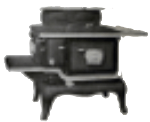A Brief History of Stoves
This page gives a brief history of stoves and kitchen ranges. Unfortunately, this history does not fit well into a timeline as there are many sub-developments which create seemingly separate timelines between developments and integrations. This is to say that though developments were made and especially as an industry grew out of the creation of kitchen stoves and ranges, that does not mean that consumers would immediately purchase new appliances with every development. Given these considerations, this is a brief explanation of some of the ways in which the modern kitchen stove was developed into its early forms.
There is no sole origin for the modern design of the kitchen stove, as many different places in North America and Europe were looking for ways to improve their open hearths and the older versions of stoves. Generally speaking, a hearth was the open fireplace built into homes which was the main way many heated and cooked going into the eighteenth century. The main problems with them were the danger presented in having an open flame, the lack of heat retention and fuel efficiency, and the amount of smoke they created was harmful, even with chimneys. Many modifications to the hearth, using bricks and flat metal plates for a cooking surface with more heat and a need for less fuel, is what precedes the creation of the modern kitchen range.
One notable inventor credited with much of the development of the kitchen range is Sir Benjamin Thompson the Count Rumford. He invented the Rumford fireplace, a design which closes off part of the chimney and uses angles to better heat a space and reduce smoke levels. This sparked the creation of brick stoves which worked well for restaurants, but not for homes that needed something more portable than the open hearth concept and that took up less space.
Cast iron stoves were developed in the first half of the nineteenth century, gaining popularity for their portability and increased fuel efficiency. This was perfect for the domestic kitchen, especially for middle-class homes that could afford them. At the same time as the base cast iron stoves were being created, run on wood and coal, the earliest gas ranges were being made. These would not gain much standing until the infrastructure was put in place to make gas accessible to more homes, which only happened in the twentieth century. This is similar to what happened with the invention of electric ranges, a uniquely Canadian invention. One of the first know electric stoves came from an Ottawa based company and inventor, Thomas Ahearn. He demonstrated its potential on 29 August 1892 at the Windsor House hotel, cooking a full meal with only electricity. Because of a lack of electrification, these appliances were also inaccessible to most people and would take decades to gain traction with consumers.
Flipbook made of "Good Cheer" Stoves and Ranges book excerpts made by the James Stewart MFG Company for 1902-1903. (Omeka entry in the Collection Gallery)
